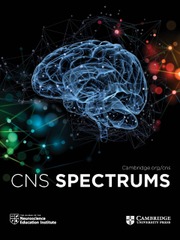Crossref Citations
This article has been cited by the following publications. This list is generated based on data provided by
Crossref.
Macedonio, Mary F.
Parsons, Thomas D.
Digiuseppe, Raymond A.
Weiderhold, Brenda A.
and
Rizzo, Albert A.
2007.
Immersiveness and Physiological Arousal within Panoramic Video-Based Virtual Reality.
CyberPsychology & Behavior,
Vol. 10,
Issue. 4,
p.
508.
Raij, Andrew B.
Johnsen, Kyle
Dickerson, Robert F.
Lok, Benjamin C.
Cohen, Marc S.
Duerson, Margaret
Pauly, Rebecca Rainer
Stevens, Amy O.
Wagner, Peggy
and
Lind, D. Scott
2007.
Comparing Interpersonal Interactions with a Virtual Human to Those with a Real Human.
IEEE Transactions on Visualization and Computer Graphics,
Vol. 13,
Issue. 3,
p.
443.
PULIER, MYRON L.
2007.
Technology, Geriatric Practice, and the Future of Psychiatry.
Journal of Psychiatric Practice,
Vol. 13,
Issue. 4,
p.
269.
Kenny, Patrick
Parsons, Thomas D.
Gratch, Jonathan
Leuski, Anton
and
Rizzo, Albert A.
2007.
Intelligent Virtual Agents.
Vol. 4722,
Issue. ,
p.
197.
Parsons, Thomas D.
Bowerly, Todd
Buckwalter, J. Galen
and
Rizzo, Albert A.
2007.
A Controlled Clinical Comparison of Attention Performance in Children with ADHD in a Virtual Reality Classroom Compared to Standard Neuropsychological Methods.
Child Neuropsychology,
Vol. 13,
Issue. 4,
p.
363.
Moller, Henry J.
Rizzo, Albert A.
and
Mikulis, David J.
2007.
Prefrontal cortex activation mediates cognitive reserve alertness and attention in the Virtual Classroom: preliminary fMRI findings and clinical implications.
p.
146.
Mühlberger, Andreas
Krebs, Harald
and
Pauli, Paul
2008.
E-Mental-Health.
p.
163.
Morency, Louis-Philippe
de Kok, Iwan
and
Gratch, Jonathan
2008.
Context-based recognition during human interactions.
p.
181.
Dyck, Miriam
Winbeck, Maren
Leiberg, Susanne
Chen, Yuhan
Gur, Rurben C.
Mathiak, Klaus
and
Baune, Bernhard
2008.
Recognition Profile of Emotions in Natural and Virtual Faces.
PLoS ONE,
Vol. 3,
Issue. 11,
p.
e3628.
Pollak, Yehuda
Weiss, Patricia L.
Rizzo, Albert A.
Weizer, Merav
Shriki, Liron
Shalev, Ruth S.
and
Gross-Tsur, Varda
2009.
The Utility of a Continuous Performance Test Embedded in Virtual Reality in Measuring ADHD-Related Deficits.
Journal of Developmental & Behavioral Pediatrics,
Vol. 30,
Issue. 1,
p.
2.
Morency, Louis-Philippe
2009.
Co-occurrence graphs.
p.
1.
Sarig-Bahat, Hilla
Weiss, Patrice L.
and
Laufer, Yocheved
2009.
Cervical Motion Assessment Using Virtual Reality.
Spine,
Vol. 34,
Issue. 10,
p.
1018.
Adams, Rebecca
Finn, Paul
Moes, Elisabeth
Flannery, Kathleen
and
Rizzo, Albert “Skip”
2009.
Distractibility in Attention/Deficit/ Hyperactivity Disorder (ADHD): The Virtual Reality Classroom.
Child Neuropsychology,
Vol. 15,
Issue. 2,
p.
120.
Anton, Raluca
Opris, David
Dobrean, Anca
David, Daniel
and
Rizzo, Albert
2009.
Virtual reality in rehabilitation of attention deficit / hyperactivity disorder The instrument construction principles.
p.
59.
Cartreine, James A.
Ahern, David K.
and
Locke, Steven E.
2010.
A Roadmap to Computer-Based Psychotherapy in the United States.
Harvard Review of Psychiatry,
Vol. 18,
Issue. 2,
p.
80.
GILBOA, YAFIT
ROSENBLUM, SARA
FATTAL‐VALEVSKI, AVIVA
and
JOSMAN, NAOMI
2010.
Application of the International Classification of Functioning, Disability and Health in children with neurofibromatosis type 1: a review.
Developmental Medicine & Child Neurology,
Vol. 52,
Issue. 7,
p.
612.
Li, Xin
Li, Minghua
and
Zeng, Liren
2010.
Entertainment for Education. Digital Techniques and Systems.
Vol. 6249,
Issue. ,
p.
446.
Pollak, Yehuda
Shomaly, Hanan Barhoum
Weiss, Patrice L.
Rizzo, Albert A.
and
Gross-Tsur, Varda
2010.
Methylphenidate Effect in Children With ADHD Can Be Measured by an Ecologically Valid Continuous Performance Test Embedded in Virtual Reality.
CNS Spectrums,
Vol. 15,
Issue. 2,
p.
125.
Fidopiastis, Cali M
Rizzo, Albert A
and
Rolland, Jannick P
2010.
User-centered virtual environment design for virtual rehabilitation.
Journal of NeuroEngineering and Rehabilitation,
Vol. 7,
Issue. 1,
Jung, Jong-chul
Goo, Bong-Oh
Lee, Dae-hee
and
Roh, Hyo-lyun
2011.
Effects of 3D Visual Feedback Exercise on the Balance and Walking Abilities of Hemiplegic Patients.
Journal of Physical Therapy Science,
Vol. 23,
Issue. 6,
p.
859.


